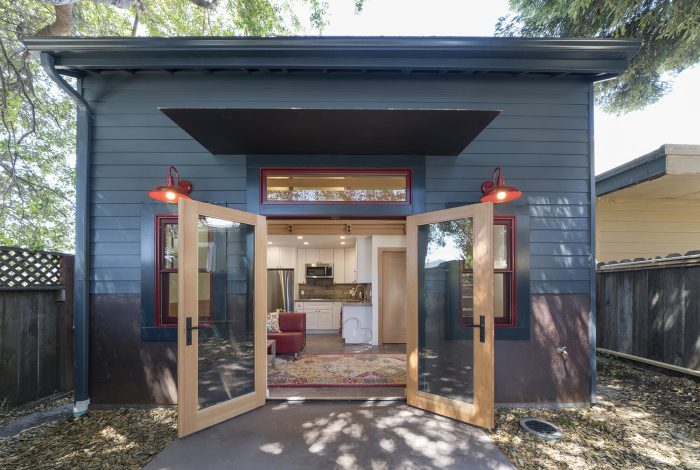
Accessory dwelling units (ADUs) are gaining traction nationwide, and we are seeing the impact in our project portfolio at Beyond Efficiency. The increase is largely driven by the easing of zoning restrictions, which makes it much easier for homeowners to create ADUs on their existing properties. These zoning amendments are trending nationwide with some of the most progressive in California and the Pacific Northwest.
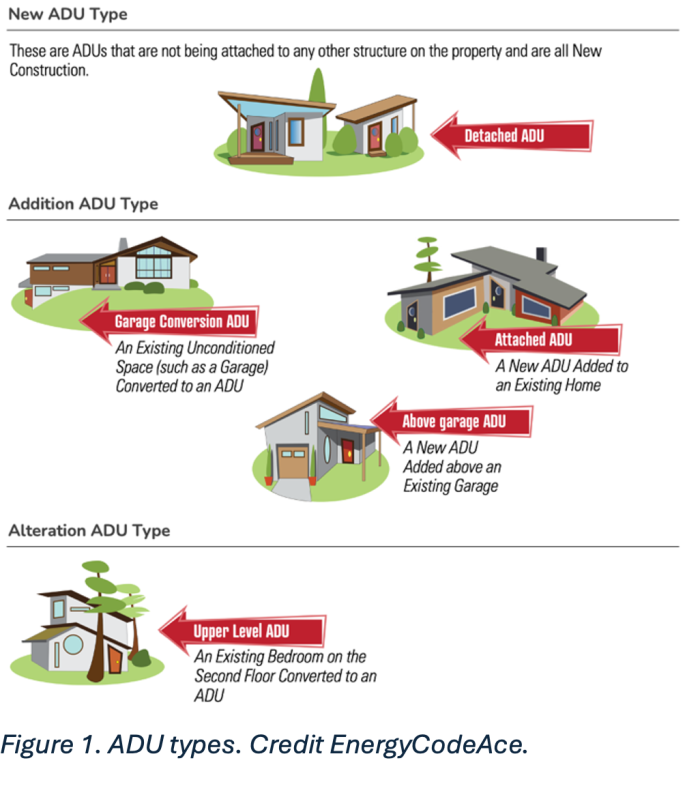
ADUs are living units that are independent from the main house, and they can be fully attached, partially attached, or fully detached. They are known by many other names including supplementary dwelling unit, granny flat, and backyard cottage to name a few. They have a kitchen, bathroom, and sleeping area (Junior ADUs, or JADUs, may share a bathroom with the main home). Size is anywhere from a few hundred square feet to upwards of 1000 sq. ft. Some zoning requirements require ADUs to be smaller than the main house, while others have fixed limits that can vary depending on whether they are attached or detached. The typical sizes we see in California range from 500-800 sq. ft.
Roadmap in the making
We have found a lot of great guidance on planning and permitting an ADU in various communities, but not so much on technical design and construction details. For example, we can find the list of what is needed for the permit package or design tips for small spaces, but little in the way of how to detail exterior walls; what heating, cooling and ventilation (HVAC) systems to use; what meets energy code; what are design nuances unique to small buildings, and so on.
To help address this market need, our team is developing regional guides that dive into those technical topics for all-electric ADUs. We just released our first guide, designed for California, Climate Zone 3. It serves as the foundation for forthcoming regional guides that are customized for local code requirements as well as variations on “Smart Practices” that detail climate-specific recommendations. Otherwise, much of the information is universally applicable. We will share some highlights here.
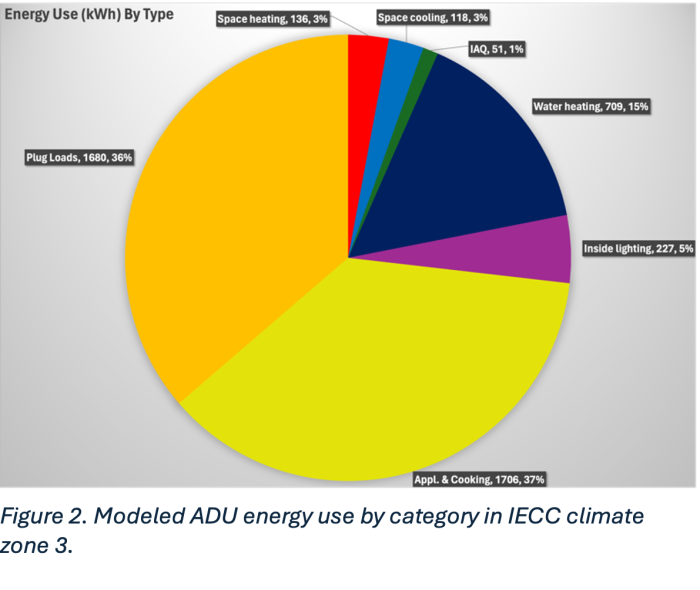
Recommended mechanical systems
In heating-dominated project locations, which covers most of the U.S., energy for water heating can approach or exceed that of space heating in smaller homes like ADUs. Specifying heat pump water heaters (HPWHs) is one of the best ways to reduce the annual energy use as these are about three times more efficient than electric resistance or gas. Note that in California, HPWHs are effectively a must for all-electric ADUs since it is generally difficult or even impossible to meet Title 24 energy compliance with an electric resistance unit.

One of the challenges with HPWHs is their installation requirements. Generally, the minimum footprint is about 2-1/2 ft. by 2-1/2 ft. plus at least 1 ft. at the front for service/control access. Some units have more demanding clearance requirements, and a larger area may be required when ducting a HPWH depending on the location of the duct connections.
These units require a large volume of air circulation to avoid over-cooling the space and so need a louvered door or ducting. Some HPWHs are noisy; in milder climates like the Bay Area they can be moved outdoors and housed in an exterior closet to isolate them from the living spaces while protecting them from the elements. In colder climates, they must be placed indoors since most models stop operating in heat pump mode once temperatures fall below about 40°F and they must be protected from freezing anyway. Garages or basements are often good locations.
On the heating and cooling side, we are generally looking at the lowest capacity heat pump systems whether they are packaged or minisplits. There are a variety of options for indoor minisplit heads that are either point source (wall hung or ceiling cassette) or distributed (ducted).
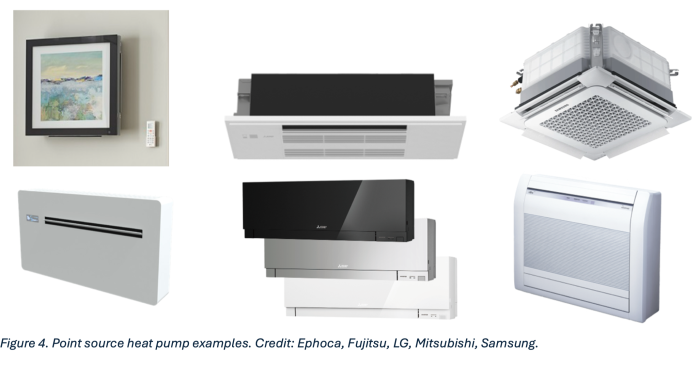
The point-source system is excellent for a studio and, depending on the layout, can work great for a 1BR particularly if the bedroom door is typically left open. Otherwise, a small supplemental electric resistance heater in the bedroom can reduce any concerns over heating distribution.
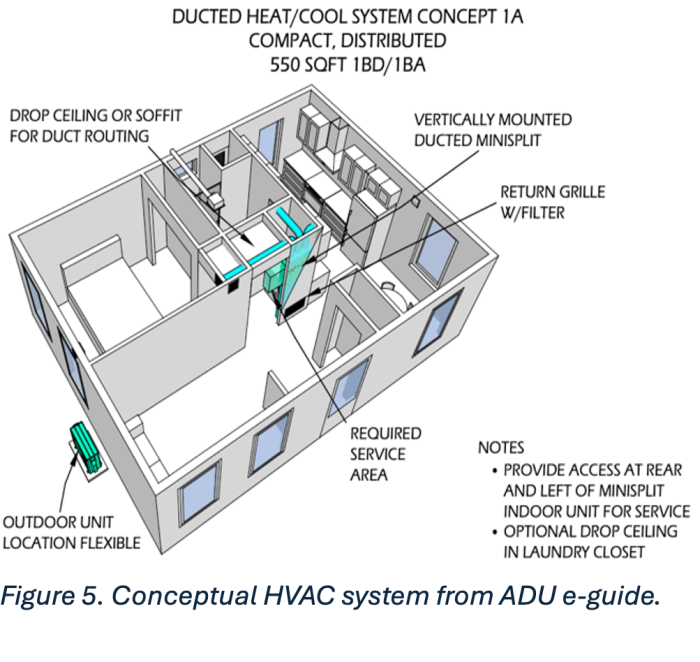
A ducted system is a great option for one- and two-bedroom ADUs and with careful space programming, a compact duct network is possible. As with any build, considering ducting and system layouts early in the planning goes a long way toward optimizing their design. One drawback is higher cost for a ducted system over a point source, perhaps as much as 50%.
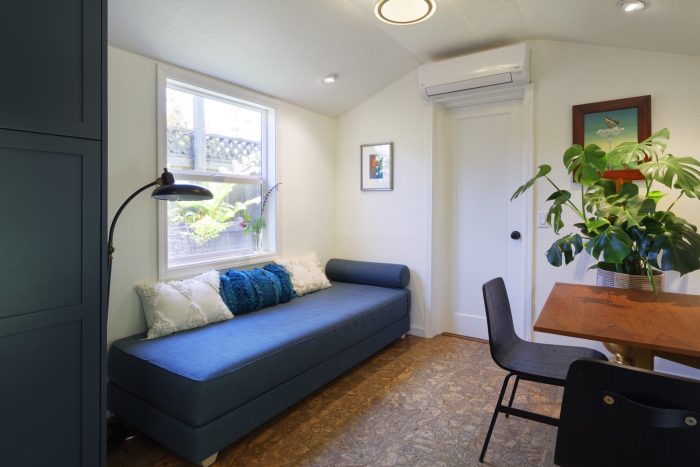
We will often find a bedroom’s heating and cooling loads are far too low for a multisplit system, where there would be an indoor unit in a bedroom and the main living area, and we recommend avoiding these.
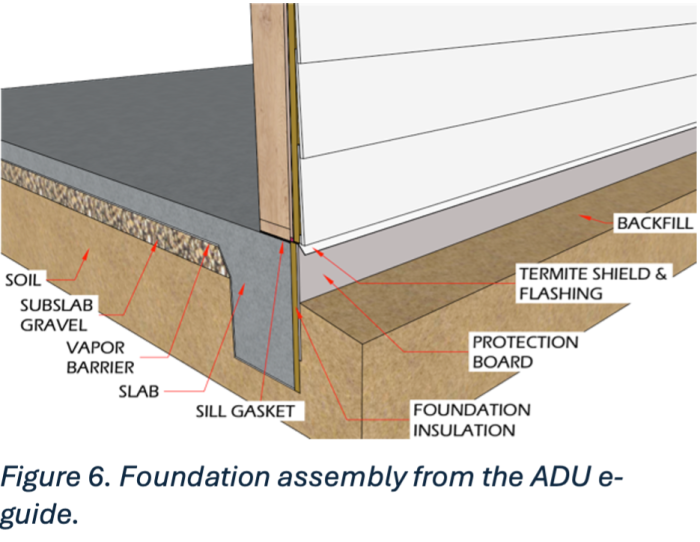
Some enclosure specifics
For small-footprint ADUs, typically built on a concrete slab, the foundation can be a big source of heat loss. Heat losses through uninsulated slab edges in smaller ADUs will typically account for at least 30% of the home’s heating energy! Insulating the slab edge can significantly reduce this energy use, and it becomes all the more important the colder the climate gets.

Our recommendations for walls are climate specific. For the Bay Area guide, and IECC Climate Zone 3 in general, we recommend 1 in. of exterior rigid insulation on a 2 x 6 wall. However, in this climate and at the ADU scale, we don’t see the inch of insulation as critical. Removing it can save some cost and complexity, which we view as an acceptable tradeoff with building performance. That said, at Climate Zone 4 we will push hard for it, and at 5 we will adamantly recommend ≥1 in. with an additional 0.5-1 in. with each step into colder climate zones.

With roofs it is often tough to justify going beyond prescriptive requirements. However, it is important to sort out moisture-safe assemblies, particularly since cathedral/vaulted roofs are common among ADUs. This boils down to ensuring ratios between air-impermeable rigid insulation on the exterior and permeable insulation in the cavities are correct, or using other means for moisture control such as vented roofs or vapor diffusion ports.
Those are some of the highlights from the current e-guide and how they can be applied to other climate zones. In this guide, we go deeper into the topics to work through various details and provide actionable guidance on enclosure assemblies and HVAC and hot water systems. We strongly believe it simplifies the technical design process by empowering users with the knowledge to make key decisions.
Footnote
We are working our way through California, covering IECC Climate Zones 2 through 6, before moving out of state. The goal is to release a regional guide every 4-6 weeks.
_________________________________________________________________________
Nathan Russell is an energy engineer manager at Beyond Efficiency. Images courtesy of author, except where noted.
Weekly Newsletter
Get building science and energy efficiency advice, plus special offers, in your inbox.




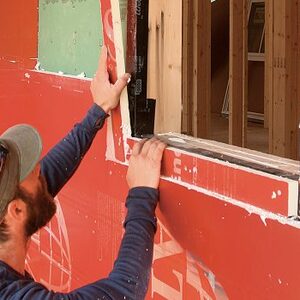
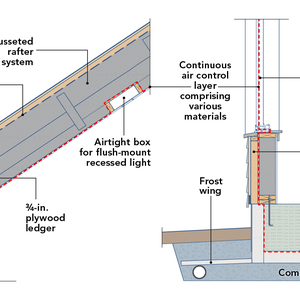
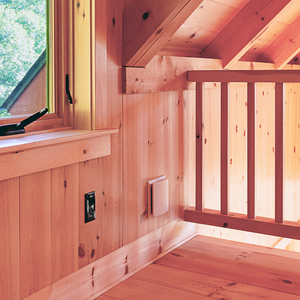
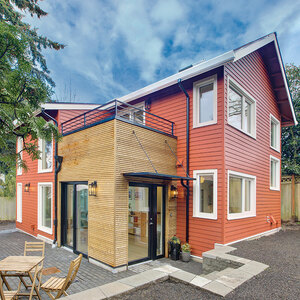






29 Comments
"In milder climates like the Bay Area they can be moved outdoors and housed in an exterior closet to isolate them from the living spaces while protecting them from the elements. In colder climates, they must be placed indoors since most models stop operating in heat pump mode once temperatures fall below about 40°F and they must be protected from freezing anyway. Garages or basements are often good locations."
I don't understand the desire to put HPWH's outdoors or in unconditioned space.
From an efficiency standpoint, they work best in conditioned space. During cooling season, they provide free cooling. During heating season they work better if they are drawing heat from the conditioned space rather than from outdoors. Yes, there is a window between heating and cooling season where they work better using unconditioned air, but in most of North America that's a small window.
I raise this because we get people in the Q&A rather regularly coming asking how to vent their HPWH. I don't know where they're getting the idea that this is a good thing to do. I don't know if it's just carryover from gas water heaters having to be vented, or if there are sources on the internet actively promoting the idea.
When placing a HPWH in an exterior closet there are some tradeoffs with energy efficiency for sure, but it’s arguably worth it to eliminate any concerns with space requirements, cooling effect, and primarily noise. When interior space is at a premium, such as with an ADU, the exterior closet can provide design flexibility. Considering the HPWH cooling effect is much more important since it’s unlikely there’ll be a utility room or basement to isolate it. It will be placed in a closet where cool output will more directly impact active living areas; the "free cooling” may sometimes be welcome but not usually. Sound mitigation would require a solid closet door and ducting the unit to other living spaces, or to the exterior in milder climates.
However, programming the HPWH to run during less impactful times, such as when away at work or sleeping, can address most of these issues. Increasing the storage temp can squeeze out more capacity and help a charge last a full day. These are essentially required for cold climates since the system shouldn’t be located or ducted outdoors.
My fingers are crossed that manufacturers will develop quieter unitary systems.
There's really no reason water heaters should be any noisier -- or unreliable -- than refrigerators. The refrigerator manufacturers just have a 100 year head start.
Increasing the storage temp has a pretty drastic impact on efficiency. The efficiency of a heat pump is dependent upon the temperature differential between the heat source -- the ambient air -- and the heat destination, the storage tank. If you're pulling from air at 70F and the tank is at 110F that's a 40 F difference. If, as an example, you're pulling from air at 55F and the tank is at 135F that's a 80F difference -- double. And your efficiency is going to be half.
This matters. The whole point of using a HPWH instead of a a resistance tank is the efficiency. If the HPWH isn't carefully placed you're giving away that advantage.
Great point about the refrigerator comparison!
Agreed that placement matters and clearly influences efficiency. But considering more realistic/real-life numbers, eg Stiebel Eltron Accelera that produces 149ºF water, ∆T's in actual conditions typically have a much smaller range than those examples, see attachment (if this unit were placed outdoors in Oakland, CA, it's rarely going to see temps below 40. COP is ~2.5 in that condition vs ~4.0 when it's 70º). And on a net annual basis we're looking at ~1000kWh total energy use for a HPWH... 10% better just isn't really a big deal IMO
I'm seeing something very different in that graph.
At 41F, 108F of lift, the COP is ~2.4 for the lower line. At 95F, 54F of lift -- half as much -- the COP is ~6.4. 6.4 divided by 2.4 is 2.7
At 59F, 90F of lift, the COP is ~3.4. At 104F, 45F of lift -- again, half as much -- the COP is ~7.2. 7.2 divided by 3.4 is 2.1.
When you halve the lift, you at least double the COP. And doubling the COP means you use half as much electricity -- I don't see where the "10% better" you're talking about is coming from.
In the real world, water heaters operated at 70F air temperature and 110F water temperature get about a 3.5 COP. If you halve that COP by poor choices of location and water temperature, you get about 1.75. Now 1.75 is better than the 1.0 that a resistance tank gives -- it's 75% better! -- but it also makes the HPWH a lot less compelling.
The reason I'm harping on this is fairly regularly over in the Q&A we get people asking about venting their HPWH to the outside. I don't know where they get that idea, but they ask. The answer is just don't. The water heater belongs inside the building envelope.
I too think it’s firmly in the “who cares” amount of electricity. However, ADUs seem so beneficial to society and the climate it is disappointing they need to have HPWHs, especially in California. That money would be so much better spent replacing an oil furnace in a cold state.
Separately - DCC, I think GBA should post an article about the efficiency of HPWH at different ambient temps. I think it’s more complicated then the “lift” calcs make it out to be, since it’s not a constant lift.
DCC, agreed that as a rough rule of thumb for most HPWHs, twice the lift (what I was referring to as ∆T in the markup of the Accelera's COP based on ambient temp) = half the efficiency. My point is that in typical conditions, and given the water temps that HPWHs produce (almost 150º in the case of the Accelera or Sanden) we're just not dealing with ∆Ts that are even close to varying by 100%. Eg in a worst-case Bay Area condition when it's about 40 outside, a HPWH placed indoors vs outdoors is about 60 or 65% more efficient (and on the flip side, it would be ~15% less efficient on a hot summer day!)
My referring to "10% better" is a guess of net annual efficiency gain of placing a unit inside vs outside in the Bay Area, maybe 100kWh, just tiny in the scheme of things. Paul, hourly energy models (like CA's CBECC-RES) take into account placement of HPWH and its related impact on water heating and space heating/cooling energy use. I feel less conflicted about HWPHs essentially being req'd for an all-electric ADUs in CA; the space req. can be a challenge but the ability to tie into grid-level demand response/load-shifting programs is SO beneficial for macro-level energy management. CA ADUs can run HW off the main home's WH in many situations and when feasible we encourage the main home to change to a larger HPWH as part of the ADU project. Win-win!
[replying to #17]
But the Accelera or Sanden aren't typically domestic water heaters, I doubt they have 1% of the market between them. And the Sanden is meant to be used for both hot water and space heating and meant to go outside. That's not at all what I'm talking about, and certainly not what Nathan meant when he said they could be housed in an exterior closet.
A typical HPWH is a Rheem or AO Smith that gets about a COP of 3.5 and is meant to work with 70F air and a 110F water temperature. They are very sensitive to placement, and they are often installed improperly because it's easier that way. This is Green Building Advisor, not Cheap Building Advisor, we should be advising people on best practices and not trying to justify shortcuts, there's enough of that that goes on without our help.
As for the comment "and on the flip side, it would be ~15% less efficient on a hot summer day!" that's also missing the point. On that summer day the HPWH is cooling the house for free, it costs nothing to run.
"I don't understand the desire to put HPWH's outdoors or in unconditioned space"
As you say, there are good reasons to put them in conditioned space. But conditioned space also costs $$$ to build. So if something can be put outside instead, there may be valid reasons for doing it that have nothing to do with the equipment itself, such as budget.
There is a long history in the building trades of doing things that are suboptimal (or worse) because it's cheaper or easier for the installer -- and most consumers won't know the difference. Just look at the threads in the Q&A.
My point is that it makes a significant difference, and GBA should be promoting the best practice , not the most expedient.
DC,
I'm also dubious of the argument that all additional space in a (let's say) $400/sq ft house costs the same. Adding 10 sq ft of floor space does not increase the price by $4k.
#26 and #27
I didn't make the argument that all square footage costs the same to build. Obviously it doesn't. Nonetheless, floor area DOES cost money to build. It's not free. Also, I was using it just as ONE example of a possible reason why people might make different choices than DCcontrarian. I could list several others but shouldn't have to.
And my point was just that other people may not share precisely the same priorities as DCcontrarian. That's why I said "there may be valid reasons", using the plural form. I believe GBA can be useful to people with all kinds of priorities. It's a useful educational source that helps people make more informed decisions. But people still come to it, and leave it, with their own needs and wants.
JGSG,
" I didn't make the argument that all square footage costs the same to build"
No - sorry if my post seemed to imply that. It was more a general observation that the argument for putting stuff outside isn't always straightforward financially.
The e-guide looks useful, but is there anything in it that is unique to ADUs in each climate zone, as opposed to other dwelling units?
I would think the most useful and adu specific info would be in regard to JADU as well as requirements for code compliance of adu (ie, how much sf, where that is measured from)
A lot of information in the guide is universally applicable across climate zones and building size such as the sections on HVAC, DHW, and envelope. We do focus on heating, cooling, and ventilation strategies for ADU size buildings, although these will be very similar across climate zones. One common issue we cover is fitting in the equipment and components without a dedicated utility room, basement/crawl, or conditioned attic. In California, there’s a lot of consternation around meeting the Title 24 Energy Code where requirements vary between the 16 climate zones. In each of the regional guides, we define smart practices that balance code compliance, cost, complexity, and carbon impacts and highlight where to focus efforts on energy efficiency. Using the prescriptive requirements as a baseline, we sometimes end up at, below, or above them depending on the component.
Good information, but I agree with Malcolm that this is no different than any other structure. I understand that ADU's might include more features that require special attention. The real challenge is in addressing the accessibility issues. The photo shows a tall threshold on the door not to mention the large out-swing door panels that make the house challenging for someone in a wheelchair. Any ADU built without accessibility and AIP features is missing a major focus and need. (I could make that same argument for new housing in general but that's another story.) As a builder specializing in this work, creating a zero-step entry while addressing moisture/drainage, efficiency, safety and durability tests our skills every time. HVAC concerns should include reachable and usable controls as well as maintenance in light of an occupants abilities. The intersection of efficiency, resiliency and accessibility is where an ADU is most unique.
Playing devil's advocate....
DCcontrarian: Perhaps it was added after, but the first part of the sentence you quoted "Some HPWHs are noisy;" seems to contextualize that reason. In a tiny space the noise from a HPWH is harder to avoid, so the minor hit in performance moving it outdoors in extremely mild climates may make sense, of course in most climates it wouldn't.
Malcom & Vincegmb: The real answer is probably that this is marketing material oriented at getting people a taste of their services and full e-guides https://buildinggeni.us/adu-e-guide and the realities of SEO.
FWIW some details of California’s energy code (which is not based on the IECC) is different between ADUs and other housing types, so it is valid to have guides specific to them. Especially since they represent ~19% of all units being built, and are usually one off designs instead of production tract homes that may only have a few different designs.
Good points, well taken.
Thx
Thank you bcade , you hit the nail on the head (I'm Nate's colleague at Beyond Efficiency). Noise from HPWHs is a consistent pain point from our clients, and ADUs rarely have a basement or tall crawlspace, isolated mech room, etc. to provide more placement options.
Regarding the focus of our first e-guide on new ADUs in a specific climate zone, you also nailed it. Many aspects of the energy code are unique for ADUs, and given their small scale, rules-of-thumb and established strategies for larger homes often just aren't relevant for ADUs when it comes to code compliance or best practices. And from a practical standpoint, it's easier for us to tackle one specific product (new ADUs in a specific climate zone) in a guide rather than cover homes of different sizes, new vs renovation or addition, etc. out of the gate. However, it's definitely true that a majority of the content is applicable for any home or small scale building.
"In colder climates, they must be placed indoors since most models stop operating in heat pump mode once temperatures fall below about 40°F"
So they take heat out of a conditioned space, that might be for example, heated by a gas furnace, and they call that efficiency? I'd call it a very expensive gas-fired water heater.
We recommend heat pump space heating as a key component in an all-electric ADU or other home but regardless of the heating type, the "cost" for the additional space heating in winter to make up for cool exhaust air from an indoor HPWH is relatively minor.
A typical HPWH should add a cooling load around 3000 BTU/hr but only when heat pump is running for those few hours a day... https://www.greenbuildingadvisor.com/question/how-many-btus-does-a-heat-pump-water-heater-exhuast-cool-down-the-area-around-it
This thread goes into the issue in great detail:
https://www.greenbuildingadvisor.com/question/where-is-the-most-efficient-place-to-get-the-heat-for-hot-water-from
Replying to 17:
Katy,
“the space req. can be a challenge but the ability to tie into grid-level demand response/load-shifting programs is SO beneficial for macro-level energy management.”
Can you elaborate here? This would apply to any connected storage water heater, correct? There’s nothing special about a HPWH in terms of demand management/load shifting.
It seems complex and expensive to install a HPWH in a space so small with the current offerings.
Paul- assuming an all-electric project goal, or building in a jurisdiction with gas ban, the issue is that CA Title 24 energy code is literally impossible to achieve for homes >500 sq.ft. with an electric resistance tank (unless part of solar water heating system🙃) - in theory homes ≤500sf can do electric resistance tankless (or tank, which could be "smart" to your point) but due to other aspects of how the Title 24 energy performance model works, even that so-called exemption is often still a no-go. That's another issue to tackle, that a lot of the energy code still isn't structured to treat ADUs "fairly" compared to larger homes.
There's a common intuition out there that small homes should have small equipment, or at least that how I describe the perception that a small home needs water and space heating systems that seem to scale with the size of the home. The question I often get from architects-- 'why do we need such a large water heater (or mini-split) for such a small home?!
At the end of the day-- a dwelling unit is a dwelling unit, and while the house is small, the dwellers aren't themselves shrunk to lilliputians. They want hot water, and to do it efficiently, it means a small efficient heater and a large storage volume.
Why shouldn't hot water be afforded its appropriate space/volume (I ask rhetorically)?
I work on many 2 bedroom houses-- some are 500 sq.ft., and some are 5000+ sq.ft. Their DHW draws vary much less than by a factor of 10.
You have people building 5000 sf two bedrooms?
Sure! Well... Technically it's 3 bedrooms since they build an ADU too which can circumvent local FAR limits, but they don't ever intend it to be a dwelling. It's a remote office. Or yoga studio. Or recording studio
But the main house is 1 primary bedroom and a guest bedroom usually. Or a room for their kid when they come to visit.
>That's another issue to tackle, that a lot of the energy code still isn't structured to treat ADUs "fairly" compared to larger homes.
This is the biggest beef I have with the energy code: it's process-oriented rather than outcome-oriented. So your ceiling has to be R-60, but you're allowed to have skylights? And you can make your house as large as you want, so long as it has the requisite insulation? And standards like ACH50 are very much dependent upon the size of the building.
Log in or create an account to post a comment.
Sign up Log in